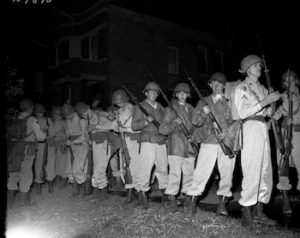
*The Cicero Race Riot occurred on this date in 1951. One of the 20th century’s worst race riots happened when a mob of 4,000 whites attacked an apartment building that housed a single Black family in a neighborhood in Cicero, Cook County, Illinois.
After World War II, white attacks on Blacks in metropolitan Chicago’s South and Southwest Sides and the western industrial suburb of Cicero increased. Black professionals seeking improved housing, whether in private residences or public housing developments, were frequently greeted by attempted arson, bombings, and angry white mobs. In early June 1951, Mrs. DeRose, who owned an apartment, rented it to Harvey E. Clark, Jr., a Black war veteran and a graduate of Fisk University, and his family in an all-white neighborhood in Cicero.
A Cicero official found out that a Black family was moving into a Cicero apartment and warned Mrs. DeRose that there would be “trouble” if they moved in. At 2:30 pm on June 8, the police stopped a moving van with Clark’s furniture. Then the jeering crowd started to gather, and the police told Clark to get out, or he would be arrested “for protective custody.” Clark was hit eight times when pushed toward the car parked across the street and shoved inside. The police told him, “Get out of Cicero and don’t come back in town, or you’ll get a bullet through you.” The NAACP filed a suit against the Cicero police on June 26.
On July 11, 1951, at dusk, a crowd of 4,000 whites attacked the apartment building that housed Clark’s family and possessions. Only 60 police officers were assigned to the scene and did little to control the rioting. Women carried stones from a nearby rock pile to throw at Clark’s windows. Another tossed firebrands onto the window and the rooftops, and 21 family members fled before the rioting. The mob destroyed a bathtub, woodwork, plaster, doors, and windows, and set fires. Most of the white rioters were teenagers. Firefighters who rushed to the building were met with bricks and stones from the mob.
The sheriff's deputies asked the firefighters to turn their hoses on the rioters, but they refused without their lieutenant, who was unavailable. The situation appeared out of control, and County Sheriff John E. Babbs asked Illinois Governor Adlai Stevenson to send in the Illinois National Guard. As troops arrived, the rioters fought with them. Armed with bayonets, rifle butts, and tear gas, the troops finally controlled the riot by setting a 300-yard perimeter around the apartment block the rioters were trying to wreck. By July 14, most of the violence had ended. When the riot was over, $20,000 in damage was done to the building.
After the United States Attorney General launched an investigation into the incident, a grand jury indicted four Cicero officials and three police officers on charges of violating Clark’s civil rights. The fire chief's charges were then dropped. The police chief and two policemen were fined $2,500.
The Cicero Race Riot of 1951 was the first race riot broadcast on local television. It brought worldwide condemnation for the first time and a dramatic climax to an era of large-scale house disorder.